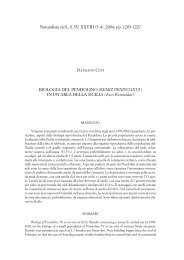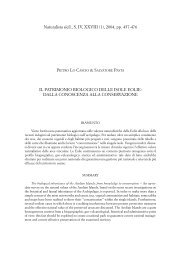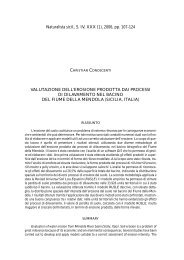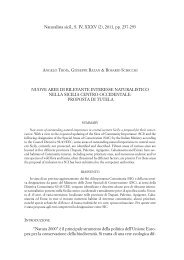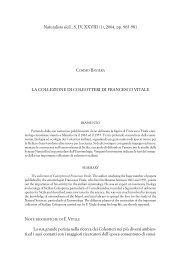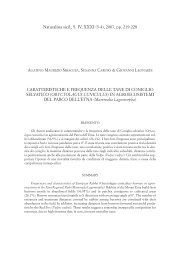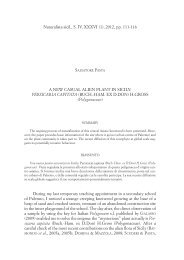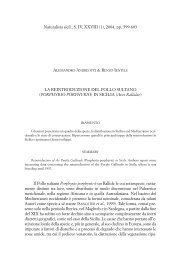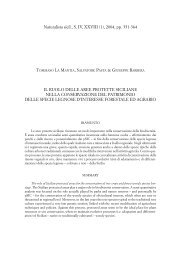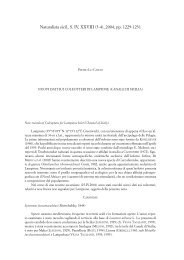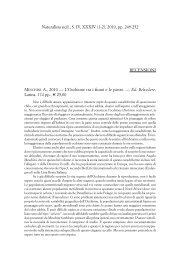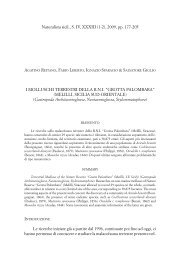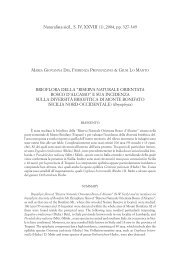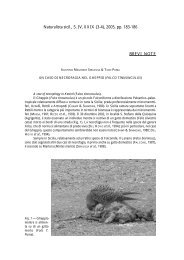2007,pp - Società Siciliana di Scienze Naturali
2007,pp - Società Siciliana di Scienze Naturali
2007,pp - Società Siciliana di Scienze Naturali
You also want an ePaper? Increase the reach of your titles
YUMPU automatically turns print PDFs into web optimized ePapers that Google loves.
284 M. SKUHRAVÁ, V. SKUHRAVY´ & B. MASSA<br />
Bocca <strong>di</strong> Falco [= Bocca<strong>di</strong>falco] in summer and in the territory of Partinico<br />
(Palermo) (100 m), on Foeniculum officinale All. and F. piperitum Dec. and<br />
afterwards (DE STEFANI, 1905a) reared in October parasitoids from galls on<br />
F. piperitum. Distribution: Euro-Siberian species widely <strong>di</strong>stributed in<br />
Europe and spread up to Kazakhstan.<br />
Lasioptera berlesiana Paoli, 1907<br />
Syn. Lasioptera kiefferiana Del Guercio, 1910; Lasioptera carpophila Del Guercio, 1918;<br />
Lasioptera brevicornis Melis, 1925<br />
Prolasioptera berlesiana (Paoli, 1907): authors<br />
Larvae develop in fruits of Olea europaea L. (Oleaceae) (Pl. VII, Fig. 43).<br />
Attacked fruits have small circular spots. Larvae live under these spots and in<br />
the galleries caused by larvae of olive fruit fly Bactrocera oleae (Gmel.) (Diptera<br />
Tephritidae). Larvae of L. berlesiana are mycophagous and feed with the fungal<br />
mycelium that develops in olive fruits attacked by Bactrocera oleae. PAOLI<br />
(1907) decribed this species under the name Lasioptera berlesiana from Maremma,<br />
Toscana. Later the species was combined with the genus Prolasioptera Kieffer,<br />
1913. MÖHN (1968) on the basis of larval morphology synonymized three<br />
species under Lasioptera berlesiana. SOLINAS (1967) stu<strong>di</strong>ed details of the biology<br />
of L. berlesiana in southern Italy and found that the newly hatched larvae<br />
destroy eggs of olive fruit fly. GENDUSO & RAGUSA (1970) and RAGUSA (1970a,<br />
1970b) stu<strong>di</strong>ed the biology of olive fruit fly in Sicily, also fin<strong>di</strong>ng larvae of L.<br />
berlesiana within fruits inhabited by flies. BLANDO & MINEO (2006) considered<br />
L. berlesiana as one of natural enemies of Bactrocera oleae. Occurrence: DE STE-<br />
FANI (1917) recorded this species in Sicily without giving a locality; currently, it<br />
is very common and widespread. Distribution: Me<strong>di</strong>terranean.<br />
Lasioptera carophila F. Löw, 1874<br />
Larvae cause unilocular swellings at bases of umbellules in inflorescences<br />
of various species and genera of the family Apiaceae (Pl. II, Fig. 11).<br />
A single larva develops in a chamber, the walls of which are covered with<br />
mycelium. Larvae of summer generation pupate in galls. Two generations<br />
develop per year. Larvae also hibernate in galls where they pupate in the<br />
spring. Occurrence: DE STEFANI (1901, 1903, 1906c) found galls in Sicily on<br />
Cni<strong>di</strong>um apioides Spr., Opoponax chironium, Daucus carota L., Elaeoselinum<br />
meoides Koch, Foeniculum piperitum Dec. DE STEFANI (1905a) reared some<br />
parasitoids from galls collected on F. piperitum. Occurrence: Ficuzza, Partinico,<br />
Palermo, mountains near Palermo. DE STEFANI jr (1942) reported galls<br />
on Cni<strong>di</strong>um silaifolium (Jacq.) in July at Ficuzza (as Cecidomyidae). Distribution:<br />
European, occurring up to North Africa; it occurs also in Turkey<br />
(SKUHRAVÁ et al., 2005).



